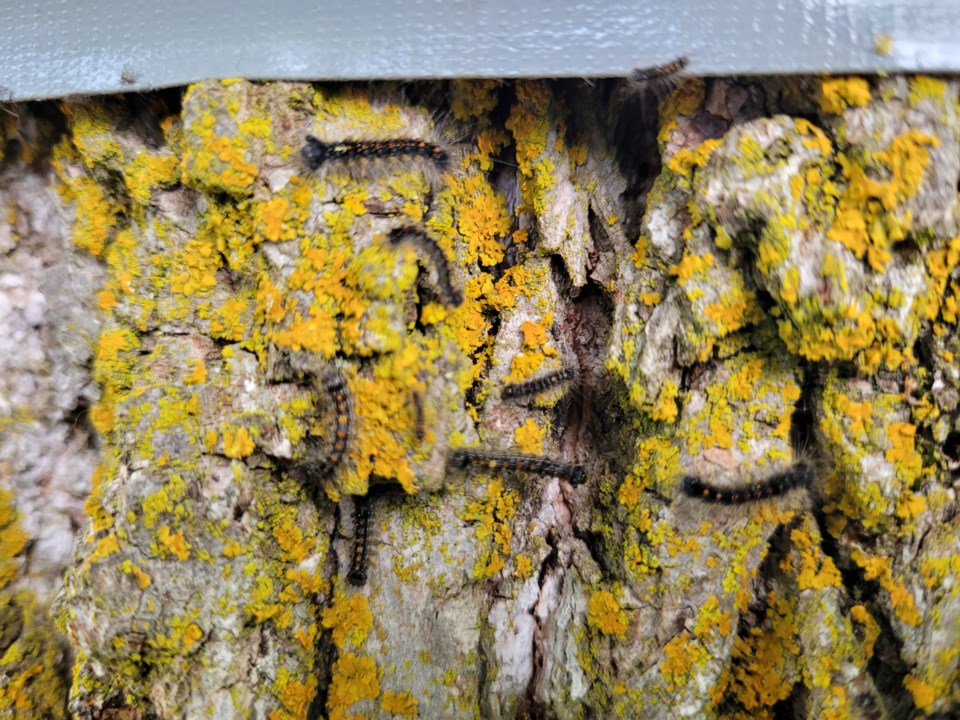There’s an invasive moth hungry for trees in Collingwood, but with a little luck, the damage it leaves behind won’t be permanent.
The local conservation authority has confirmed earlier predictions by Simcoe County and the Ministry of Natural Resources and Forestry that 2021 would bring an outbreak of European gypsy moths.
The Nottawasaga Valley Conservation Authority (NVCA) published a bulletin on the invasive species, noting there will be a peak in the population of the destructive caterpillars and moths this year and likely for the next couple of years.
Rick Grillmayer, the NVCA’s manager of forestry said he’s seen caterpillars travelling across large fields in search of foraging areas.
“When populations of gypsy moth are as high as they are anticipated for this year, there really isn’t much landowners can do to control the infestation, other than to patiently wait it out,” said Grillmayer in the NVCA bulletin.
In Collingwood, Parks Manager Wendy Martin confirmed there are spots where the gypsy moth has become prevalent.
“We have a couple of hot spots in town, Mair Mills is one area,” said Martin.
However, the town is taking the ‘wait patiently’ approach.
“Currently the town does not have the resources to control gypsy moths on private or town land,” said Martin.
The County of Simcoe’s forestry department reports gypsy moths are non-native invasive insects from Europe, and they’ve been in Ontario since 1969.
The caterpillars feed on deciduous and some coniferous trees in May and June, causing trees to lose their leaves (defoliation) during peak years. They seem to like oak trees, and though they look similar to tent caterpillars, they do not make tents.
Though trees can suffer and even die from multiple years of defoliation, that is not always the case.
“As population levels [of gypsy moths] typically collapse back to low densities within one to three years of outbreak, no substantive or long-lasting impacts to overall forest health has resulted historically,” states the Simcoe County Forestry website.
According to an egg mass survey of county forests in 2020, the most noticeable impacts have been in the Midland, Tiny, Penetanguishene, Tay, and Adjala-Tosorontio areas.
The Ontario Ministry of Natural Resources and Forestry (MNRF) has mapped areas with defoliation caused by gypsy moths in 2020 and confirmed a general outbreak across much of the province. You’ll find the mapping here.
The City of Barrie is trying to combat the caterpillars with insecticide injections into the tree and wrapping the trunks in tape, sticky side out.
Living Green Project director Andee Pelan told BarrieToday it is anticipated that trees in Simcoe County will be severely affected this year.
“The European gypsy moth has a seven- to 10-year cycle … this year will see a peak in its population cycle,” said Pelan. “Typically, when populations rise rapidly, they are usually followed by a crash from a host-specific virus or fungus.”
The county has confirmed the presence of Nucleopolyhedrosis virus (NPV) and/or Entomophaga maimaiga fungus in the county forest areas and confirmed it has caused insect mortality.
Pelan said using tape to try to prevent the caterpillars from eating the tree isn’t necessarily the best idea.
“There have been quite a lot of reports of other wildlife, like birds, getting trapped as well. We will, however, be using the burlap wrap-trap technique in a couple of weeks though,” she said. “This will include physically picking the caterpillars off the tree and drowning them in a bucket of soapy water just like we did with the Japanese beetles.”
"It's pretty gross, but it works.”
The NVCA said the area may also get some help from the skies, but not in the form of aerial spraying, which has to be widespread and can be detrimental to native butterflies and moths.
“During our spring bird monitoring surveys, we’ve seen a noticeable increase in bird species that specialize in eating caterpillars like gypsy moth,” said Dave Featherstone, a senior ecologist at the NVCA in their latest bulletin. “We are more frequently coming across avian species like the black and yellow-billed cuckoos and the rufous-sided twohees. We also saw black-capped chickadees eating egg masses during the winter.”
Martin directed Collingwood landowners who might be seeing evidence of gypsy moths and caterpillars on their trees to the County of Simcoe website where there is a list of resources and information on how to find a certified arborist or professional forester to help.
- With files from Shawn Gibson



